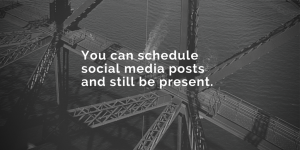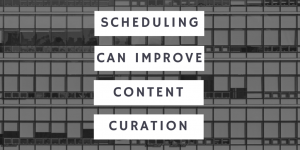I’m not a fan of automation.
Automats? Big fan. Automated processes? Of course (where they make business sense). But automated posts? Not so much.
The problem with automation in social media channels is that you end up with people and brands who are not active on a social media platform but push out content (usually their own). Not to mention that it defeats the purpose of being, well, social.
I’m sure this has happened to you: you leave a comment on a post, offer your opinion, or just say hello to the sender–and nothing. I’m not talking insta-response. I mean not that day. Maybe not ever. Then you look at the person’s Twitter feed (or Instagram, Google+, or other account) and realize they’re just not present. Delete. Unless they’re pushing out really, really, useful content, I’m not interested in using my social media feeds as a news ticker.
Because of my distaste for automation, I’ve been very slow to make use of social media scheduling tools. An occasional scheduled post in TweetDeck–but little more than that. Until three months ago when I finally took the plunge and started experimenting with scheduled posts.
Here’s what I’ve learned.

You can schedule social media posts and still be present.
I used Buffer to set the following schedule:
- Twitter: 4x Monday-Thursday; 3x on Friday
- Facebook: 1x Monday-Friday
- LinkedIn: 1x Monday-Friday
The schedule is designed to reach different people at different times during the day. In the past, the bulk of my curated content was shared in a giant data dump (often late afternoon when I traditionally get around to digging into Feedly); now it’s spread out across the day. This both gives me a more consistent presence, especially on Twitter, and a broader reach.
My schedule is also designed to post content at times that I am present. I’m not always online–but I am around enough to monitor my accounts and be responsive. (At minimum, within the course of the day.) In addition, I try to look each morning to remind myself what posts I’ve scheduled for that day so I’m prepared for the response.
I’m more mindful of my networks.
Posting regularly to LinkedIn and Facebook has made me far more mindful of these networks. Being active in LinkedIn conversations is a work in progress, but at least I’m marginally more present. As for Facebook, this gets me to peek in and see what’s new from my community there.

Scheduling can improve your content curation.
In addition to reach, I’m finding that scheduling enables me to share more deliberately. Being able to look at my calendar of content and shift items around means I can schedule that gorgeous photo on Friday afternoon instead of putting a deep dive piece on data analytics in front of you for your weekend reading pleasure.
Equally important, seeing a day or a week’s worth of content makes me more aware of what content I’m sharing. It’s easier, for example, to understand whether I’m heavy on marketing pieces or developed an obsession for gadget stories. So it’s not just better recognizing what I’m sharing; it’s also being more aware of curating content that matters to the various segments of my audience.
The numbers help tell the story.
Looking at my numbers over the last three months tells me that my scheduling strategy is paying off in terms of audience growth and interaction. Twitter has very useful analytics. So does Buffer. I’m particularly fond of the “click” statistic in Buffer’s analytics, which helps me identify my most-clicked posts. It’s a useful insight because they are often posts that otherwise attract little apparent interaction (i.e., favorites or retweets).
Your schedule is a moving target.
I’m constantly tweaking with my posting schedule.
I learned, for example, that posting late on Friday afternoon (when I’m checked into the weekend) is silly. Similarly, I’ve pulled the schedule on holidays–or modified it with a single scheduled tweet that’s conscious of the fact that it is a holiday. And, with anything scheduled, you have to know when to pull the plug when the social media-verse is singularly focused on something else.
Feature photo by Jeff Hart (Flickr).



